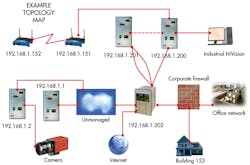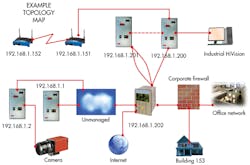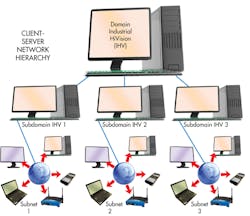Ethernet is becoming ubiquitous on factory floors. Expectations are, for example, that Ethernet nodes in the process industries will nearly double over the next few years. The market research firm IMS Research, Englewood, Colo., thinks the number of industrial Ethernet nodes in process industries will rise to 8.7 million units in 2016, nearly doubling in a span of just a few years. “Networking is becoming more of a commodity, which means that remote monitoring and control is more accessible. This is also true of discrete automation,” says IMS analyst for industrial Ethernet and fieldbus technologies Tom Moore.
IMS points out that the vast majority of remote terminal units and distributed-control systems are already networked. About 95% of new units are expected to be network enabled in 2016. And the use of industrial Ethernet is expected to grow across industrial automation. One reason: Networks are viewed as a means of bringing visibility to manufacturing data. A recent study of manufacturing executives by the Aberdeen Group, Boston, found that these managers ranked manufacturing data transparency as a top business pressure. Moreover, Aberdeen found that the best manufacturers used networking capabilities to good advantage. The top performers had better operating metrics than their competitors in areas such as operating margins, downtime per year, and cost of ownership.
No question that networks of industrial-Ethernet-enabled devices can be complex. One interesting fact to come out of Aberdeen’s research is that best-in-class companies are far more likely than their less-able competitors to equip their industrial networks with a special kind of software called network-management software (NMS).
NMS was once considered a convenience. It could help network administrators install, commission, manage, and troubleshoot. As networks have grown larger and more complex, network-management software is quickly becoming a necessity.
Network-management software monitors the network and automates many tasks involved with running a network. For example, in the case of a partial network outage, the software can detect the presence of an alarm and tell the operator where the problem is. Without such software, operators generally must walk around to learn the status of devices on the network. Network-management software lets them determine status remotely or centrally, even for the network infrastructure (cabling).
Network-management software lets operators see which links are up and down; in fact, it is hard to identify cable problems without such software. Similarly, it can show operators which devices are active and which have problems. For example, it can be used to trigger an alarm when a network device heats up so technicians can preemptively manage the situation.
Network-management software also comes in handy when redundant devices fail. If a device goes down and a redundant unit activates, technicians might not notice without this software in place.
The management functions of network-management software include noting faults, configuring network devices, accounting, monitoring network performance, and handling security. An NMS can also discover what devices are on the network, monitors their health and status, alert operators about conditions that degrade system performance, and identify problems, their source(s), and possible solutions. An NMS employs various protocols such as SNMP (Simple Network Management Protocol) to accomplish these tasks.
Network statistics
It becomes easier to understand what kind of a network can benefit from an NMS by examining a few of the tasks it normally handles. A good rule of thumb is that an installation that needs managed switches will benefit from deploying an NMS. Each managed switch or router has a software “agent” running on it that sends information to the NMS. In industrial settings, the NMS might monitor hardware devices that would include switches, routers, and PLCs.
The NMS also collects network-device statistics. It may as well maintain an archive of previous network statistics including problems and solutions that were successful in the past. If faults recur, the NMS can search the archive for the possible solutions.
NMSs were initially designed with office environments in mind. In an office setting, networked devices are typically just computers, printers, fax machines, and so forth. Enterprise-network management tended to be text based, with support for office topologies such as mesh, bus, or star.
As industrial networks began migrating to Ethernet and became more complex, plant engineers grew more interested in the benefits of automated-system management. But enterprise-management systems lacked the ability to work with industrial control regimes like Scada and did not support industrial topologies which frequently include ring configurations.
Today it is possible to find NMSs that target industrial networks. But many of these industrial NMSs are designed to work best in homogeneous hardware environments, those that contain network equipment from only one vendor. Some industrial NMSs may only recognize and monitor devices coming from the same vendor as the NMS. That’s problematic for many larger industrial installations hosting hardware from numerous network and machine vendors.
In addition, some NMSs have only limited ability to characterize new devices. Characterization might involve details such as the operating temperature of a network device or multicast control parameters. (In multicast, a source sends a packet only once, even if it must go to a large number of receivers. The nodes in the network replicate the packet to reach multiple receivers when necessary.) For example, the NMS typically lets operators know that multicast is available. More-advanced management systems such as Industrial HiVision provide the operator with granular information about the flow of multicasts across a network.
Some industrial NMSs are designed to be more general, or open. But they typically lack the detailed device characterizations described above; they only allow monitoring information at a high level, not down to parameters. There is also wide variation in the graphic capabilities that these management systems provide.
The management of industrial equipment has changed as industrial networking has evolved. Newer installations may be organized into cells with localized network management. Today, industrial-Ethernet networks connect an increasingly broad variety of devices. While the networks may be arranged into subnets for management and security reasons, it is possible, and often desirable, to create system-wide management for collecting and analyzing data centrally.
As network size and complexity rises, the argument for automated network management becomes stronger. Manual upgrades, configuration changes, and other administrative functions can chew up a lot of time when large networks are involved. Moreover, the volume and complexity of the relationships introduce numerous opportunities for errors during network operations that are manual. In addition, manual troubleshooting typically involves appreciable downtime.
Finally, it is often beneficial to have early warning indicators when a process or machine drifts off true. This has long been true for production machines and is just as valid for the network infrastructure. The NMS can do baselining or determine operating thresholds for network gear. For example, it might note the temperature threshold for a network switch that would signify overheating. Other examples include monitoring qualities such as bandwidth utilization or received power on fiber cables. It might also note changes in network traffic patterns, which could indicate that malware is present or that something is not working properly. In addition, it might note the number of network errors — if they are rising, then technicians should investigate before the network stops working.
Good network management
A bulletproof industrial NMS, such as Hirschmann’s Industrial HiVision, can significantly reduce network install time, keep network infrastructure consistent, and automate documentation. It maps, configures, and tests all devices on the network and confirms the integrity of the cables running between them. This is helpful because the larger the network, the more difficult it is to manually find a configuration error “somewhere” among the devices on it.
An NMS should provide detailed topology maps in real time. It should also be able to discover even unmanaged switches without help from the operators. A good system will make it easy for operators to oversee an entire network by, for example, letting them automate repetitive but essential maintenance tasks, such as changing passwords regularly and implementing firmware updates.
Modern NMSs for industrial networks include a graphical interface and advanced monitoring that simplifies preventative maintenance. This software also helps spot problems, including cable faults, that might otherwise cause shutdowns. In contrast, manually troubleshooting these sorts of issues may require that technicians shut down a portion of the network so a process engineer can examine it. A good NMS makes it easy to identify problematic connections and offers tools that can dig down from the port to the switch and even to the cable to identify a potential failure. This capability practically eliminates unplanned downtime.
Centralized-network management requires an industrial NMS be capable of recognizing and interacting with heterogeneous devices — network switches, SMNP-enabled PLCs, printers, and so forth — that all come from different vendors. The workload rises if network zones within a facility or isolated groups of different types of network devices must be managed separately.
One of the most important functions of an NMS is to provide a centralized table of device properties. Industrial HiVision, for example, offers a software tool that lets automation engineers simultaneously configure the same parameters for multiple heterogeneous devices. This ability saves time and eliminates errors when commissioning the system and while the network operates. Industrial HiVision automatically recognizes and depicts the network topology, including unmanaged switches and hubs. This is a valuable feature that lets operators view — and automatically document — the entire network.
Finally, modern NMSs now work through a client/server architecture that allows for managing subnets as well as enabling centralized control. This is particularly helpful with large and/or distributed networks that can benefit from multiple sets of eyes watching network operations and from the ability to delegate certain management functions to various stations. In addition, the processing power of an individual PC is no longer a limiting factor in the size of the network that can be managed.
Resources: Belden Inc. | Wikipedia page on network management systems



